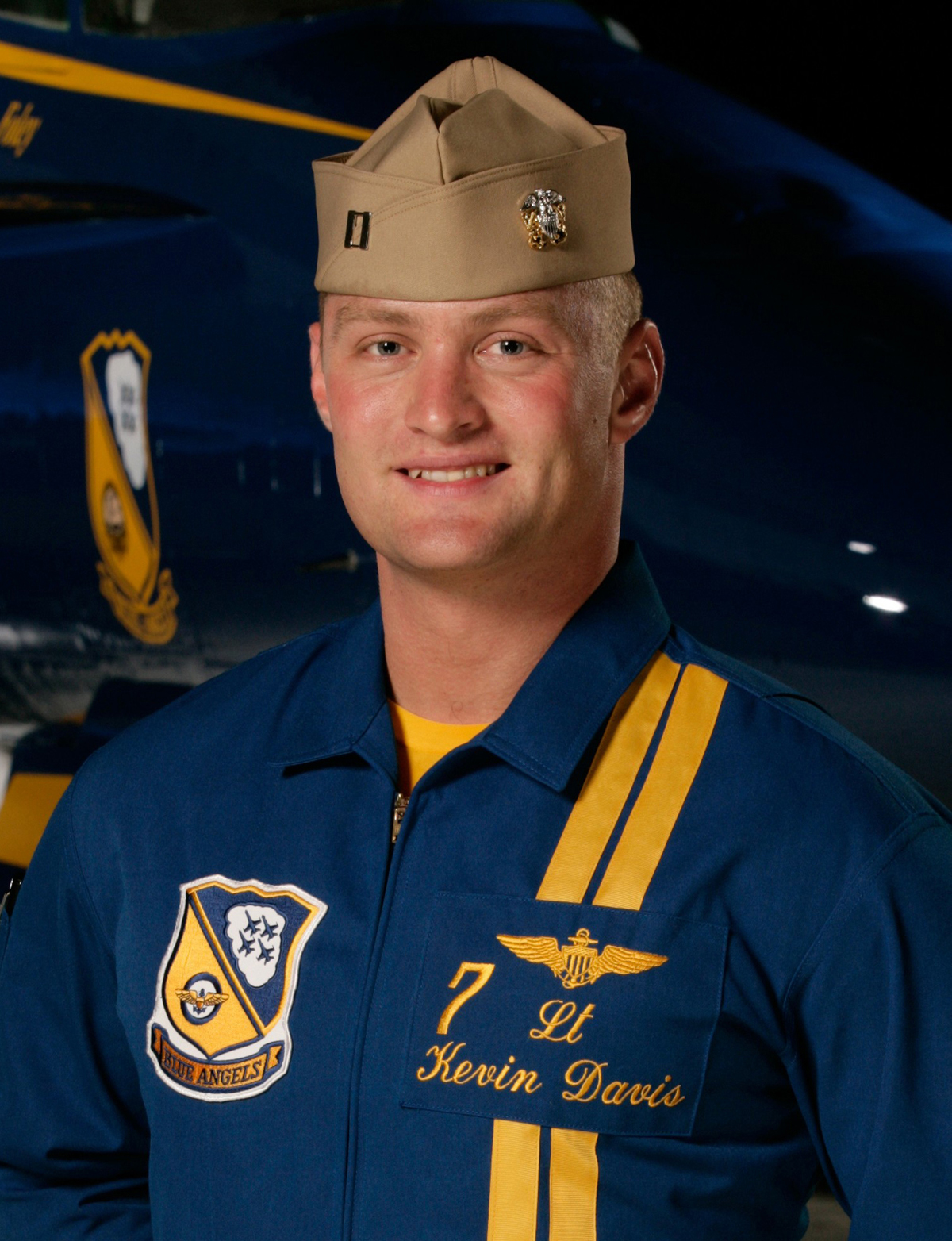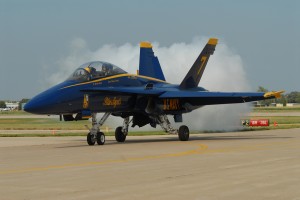By Clayton Moore
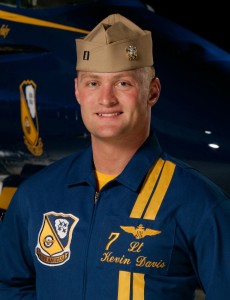
Lt. Cmdr. Kevin J. Davis was an 11-year veteran of the U.S. Navy, a graduate of the celebrated “Top Gun” fighter school and a decorated combat pilot.
The nation’s preeminent military aerobatic team, the Blue Angels, grieves for the loss of one of its finest pilots. The team’s shock and regret came hard on April 21 with the fatal crash of Lt. Cmdr. Kevin J. Davis during an air show in Beaufort, S.C.
The accident cost far more than just the team’s #6 aircraft, a multimillion dollar F/A-18 Hornet. The team is suffering emotionally with the loss of its highly trained pilot and friend, known among his aviator peers under the call sign “Kojak.” The Massachusetts native and graduate of the Navy’s elite “Top Gun” training program was 32 years old. It was his second year on the team and his first as a demonstration pilot.
“He was fascinated with airplanes from the time he was little,” Betty Sweeney, a former neighbor, told Boston media outlets. “He knew what he wanted to do, and he did it. That’s the only relief—that he went knowing what he wanted to do.”
The incident occurred at the end of the Blue Angels’ Saturday performance, at approximately 4:00 in the afternoon. At the end of the routine, all six of the Blue Angels joined in the “Delta Formation.” After a series of passes, loops, rolls and other aerobatic maneuvers, the team began its signature “Fleur-de-lis” closing maneuver. Davis was in the process of joining his teammates for this final display when his aircraft crashed.
Witnesses reported that his jet appeared to clip a power line and then the top of a pine tree during a sharp turn. The aircraft subsequently crashed at high speed into a residential neighborhood outside Marine Corps Air Station Beaufort, which was hosting the two-day air show. The plane slid for 200 to 300 yards, crashing through homes and buildings. Neighbors reported hearing an “earth-shattering rumble” and seeing a “huge fireball.”
Marine Corps spokesperson Capt. Sarah Kansteiner said the crash injured eight people on the ground and damaged eight structures. None of the injuries were reported as life-threatening.
The Blue Angels canceled their Sunday air show appearance and a subsequent scheduled event in Vidalia, Ga. The Beaufort community marked Davis’ loss during Sunday’s show. The Geico Skytypers, a civilian aerobatic team, honored Davis with a missing man formation during the opening ceremonies.
Sunday’s show also included a moment of respect for Davis by both military and civilian officials. Maj. Gen. Kenneth Glueck Jr., the commanding general of the 2nd Marine Aircraft Wing, and Col. Robert Lanham, commanding officer of the Beaufort Air Station, joined show announcer Rob Reider, Beaufort Mayor Bill Rauch and other city officials in accepting the colors from a four-man Marine Corps honor guard.
The Blue Angels returned to their home base at Pensacola Naval Air Station. Fla., to mourn their loss and assess the event.
“Our squadron and the entire U.S. Navy are grieving the loss of a great American, a great naval officer and most of all, a great friend,” said Lt. Cmdr. Anthony Walley, who flew the Blue Angels’ #2 jet during the air show performance.
The U.S. Navy Command is investigating the accident. In its 60-year history, 24 pilots from the group have been killed in air show or training accidents. The group’s fatality rate is considered very low, largely due to its thorough training. Before this tragedy, the most recent crash involving the Blue Angels occurred in 1999, when two aviators were killed in Georgia during a training flight.
Once a Blue Angel, always a Blue Angel
At the air base in Pensacola, Davis’ parking space was turned into a spontaneous memorial with flowers and posters.
“God bless your soul,” a signs reads, and “Fly high, Blue Angel.”
Davis was a native of Pittsfield, Mass. His success in the Navy, and with the Blue Angels, in particular, was a point of pride for his hometown.
Davis was the youngest of John and Ann Davis’ three sons. The oldest son, Christian, is a Navy supply officer, and middle brother Phil is a teacher in China.
The Davis family moved to Reading, Mass. while the children were young. Davis graduated from Reading Memorial High School in 1992, where he played football. He loved riding motorcycles and supported the Boston Red Sox. Steve Beatty, a reporter from the Atlanta Journal-Constitution who had taken a demonstration flight with Davis, said the pilot loved New England, dubbing it “just a good area to call home.”
“Kevin was a highly motivated young man,” said former neighbor Tom McGill. “He loved planes even when he was a little boy. We occasionally drove him up to the airport. He loved the idea of flying. He was a good student and a very conscientious young man.”
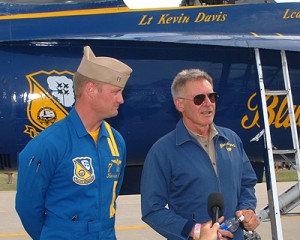
Pilot and actor Harrison Ford comments about his flight with Lt. Cmdr. Kevin Davis during EAA AirVenture.
Davis studied aeronautical science at Embry-Riddle Aeronautical University and graduated with honors in 1996. He reported to Officer Candidate School and aviation indoctrination in Pensacola in September 1996. He completed primary flight training in Corpus Christ, Texas, and transferred to Meridian, Miss. for intermediate and advanced flight training. There, he flew the T-2C Buckeye and TA-4J Skyhawk, earning his gold wings in June 1999.
He reported to Fighter Squadron 101 at the Naval Air Station in Oceana, Va., for training in the F-14 Tomcat. His mastery of the aircraft earned him “Top Stick” status in his class. In July 2000, he reported to the VR-11 “Red Rippers,” where he completed extended operations in the Arabian Sea on carriers USS Dwight D. Eisenhower and USS John F. Kennedy. These deployments also supported “Operation Enduring Freedom,” the U.S. military response to the 9/11 attacks.
In 2003, Davis joined Strike Fighter Squadron 125 at Lemoore, Calif., where he began flying the F/A-18 Hornet. He then reported to the Fighter Composite Squadron “Omars” at Naval Air Station Oceana, Va.
Davis served as a Navy adversary pilot, providing fleet squadrons with valuable air-to-air combat training. In December 2004, he graduated from the famous Navy Fighter Weapons School known as “Top Gun.”
Davis, who has said that he wasn’t much of a thrill-seeker, joined the Blue Angels in September 2005. At the time of his accident, the accomplished pilot had accumulated more than 2,500 flight hours and 200 carrier assisted landings.
His duties outside of his demonstration flights included narration for the air shows, as well as flying celebrities like singer Kelly Clarkson and actor James Franco, who appeared in the film “Flyboys.” His military awards included the Air Medal, two Navy and Marine Corps Achievement Medals and various personal and unit awards.
The Blue Angels were founded in 1951 as goodwill ambassadors for the U.S. Navy and Marine Corps. The team performs for an estimated 15 million people at air shows each year. Beaufort organizers estimate that approximately 90,000 people attended the show the day of Davis’ crash.
“The whole nation is impacted by something like this,” said former Blue Angels pilot and Pensacola City Mayor John Fogg.
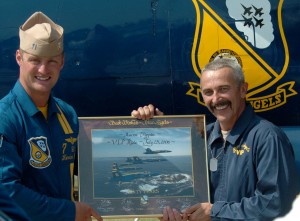
Lt. Cmdr. Kevin Davis helps country singer and pilot Aaron Tippin display his VIP ride certificate at EAA AirVenture 2006.
Davis’ entire flying career is a testament to the enduring spirit of the U.S. military’s finest aviators. His life recalls the words of the Blue Angels Creed, a statement of conviction bestowed on each member of the group on the day each officially becomes part of the team.
“Today is a very special and memorable day in your military career that will remain with you throughout your lifetime,” the creed reads. “You have survived the ultimate test of your peers and have proven to be completely deserving to wear the crest of the U.S. Navy Blue Angels.”
The creed goes on to say that the prestige of wearing the Blue Angels uniform carries with it an extraordinary honor—one that reflects not only on the pilots as individuals, but also on the entire squadron.
“To the crowds at the air shows and to the public, at hospitals and schools nationwide, you are a symbol of the Navy and Marine Corps’ finest,” it reads. “You bring pride, hope and a promise for tomorrow’s Navy and Marine Corps in the smiles and handshakes of today’s youth. Remember today as the day you became a Blue Angel; look around at your teammates and commit this special bond to memory. ‘Once a Blue Angel, always a Blue Angel,’ rings true for all those who wear the crest of the U.S. Navy Blue Angels.”











